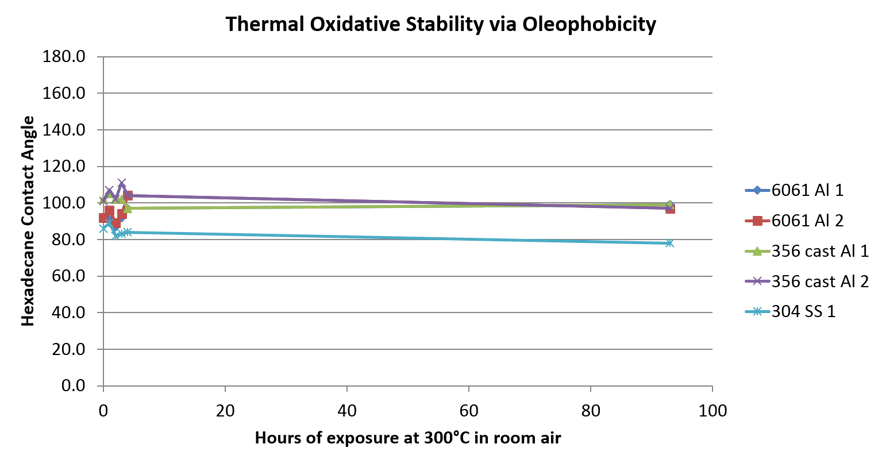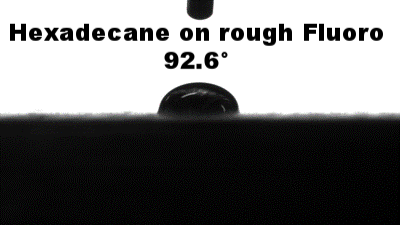
We compare coating surfaces and investigate the impact of surface energy on coating performance. What does a water drop have to say about coating quality? Here's what we learned.
A water drop can have a lot to say about the surface energy of a coating. To be sure you're getting the right coating for your application consider employing a water drop contact angle measurement tool to assess the surface energy, attraction and repelling forces, and moisture resistance of a coating. A water drop contact angle measurement can help understand the relationship between a fluid and surface and can potentially help to prevent fouling.
|
In this blog post you will learn.
- The benefit of a hydrophobic, water repelling surface.
- How to change the surface energy of a part.
- How a high energy hydrophillic surface may be the better choice for your application.
- How oils or hydrocarbon based materials can react with moisture repelling surfaces.
- How to measure a water repelling surface.
|
The benefit of hydrophobicity
A hydrophobic surface is a water repelling, low surface energy surface that resists wetting. Moisture contact angle measurements will classify a surface as hydrophobic when the contact angle of the water droplet exceeds 90 degrees. Exceed the 150 degree contact angle mark and the surface will be classified as superhydrophobic. Water will jump right off the surface as seen in this video.
There are many benefits of a moisture repelling surface. They include:
| Surface icing prevention |
Condenser & evaporator fouling prevention |
| Improved corrosion resistance |
Prevent moisture contamination in heat trace tubing |
| Produced water filtration & management, prevent filter fouling |
Improved reliability in continuous emissions monitors (CEMS) |
| Improved moisture detection instrumentation |
Improved separation and corrosion resistance in HPLC medical diagnostics |
| Manage moisture contamination in liquid natural gas systems |
Prevent contamination in analytical sample transfer systems |
Hydrophilic Surfaces
Not to be outdone, hydrophilic surfaces have benefits as well. What are hydrophilic surfaces? They are high surface energy substrates that attract water and allow wetting of the surface. They typically have a droplet contact angle measurement of less than 90 degrees. Lots of surfaces tend to be more water friendly including, glass, steel, or stainless steel and many coatings and paints. Of course test results can depend on the surface roughness and surface energy of the material you're testing.
Learn How To Improve Moisture Resistance, Fouling Resistance, and Corrosion Resistance. Get Our Presentation.
Benefits of a moisture friendly surface include:
| Improved separation in medical diagnostics (application dependent) |
Improved efficiency in heat transfer devices and heat exchangers |
| Improve acceptance of In-body devices |
Improve surface interaction in filtration devices (application dependent) |
How do I get a surface to match my desired level of moisture resistance?
You don't have to make a super radical change to material or product construction in order to change the moisture resistance of a product. Fortunately we offer silicon barrier coatings with a wide range of water management capabilities. Want a more corrosion resistant or inert coating with a low surface contact angle? Try SilcoNert® 1000 or Silcolloy®. If you're looking for an inert coating that's not too moisture repelling, go with SilcoNert® 2000. Need maximum water repelling coating properties? Dursan® or our new Notaksm Fluoro coating surface may do the trick. Notak is in pre-production Beta testing so we have limited capacity for that coating. Contact our Technical Service Team to discuss your application and we'll be happy to make a coating recommendation.

The comparative graph above highlights the water repelling properties of each of our coatings compared to stainless steel; each coating has specific applications and benefits. Go to our applications guide to get the lowdown on each of our coatings.

Oil and Hydrocarbon Exposure
Low surface tension liquids like oil or organic solvents are designed to wet the surface for maximum lubrication or solvation. But what if you're separating organics or don't want the surface to wet? Water repelling materials like PTFE aren't effective in repelling oil. Here's what oil and hexadecane look like when placed on a PTFE surface.
We bonded our new Notaksm fluoro material on a rough stainless steel surface to see if the contact angle would increase. The Notak surface material made a big difference in contact angle, making the stainless steel oleophobic surface.
Given the nature of refining or cleaning for that matter, we can expect the surface to be exposed to elevated temperatures. PTFE is high temperature limited and can fail in many high temperature applications. We exposed the Notak surface to elevated temperature (300°C) for several hours to gauge the impact to wettability and contact angle on various surfaces. The graph below shows consistent contact angle readings over the 90+ hour test. PTFE would have failed at 250°C.

The contribution of surface energy and it's relationship to process fluids can have far ranging impacts. Surface interaction can impact corrosion, fouling, analytical sampling results, filtration and medical device performance. So it's important to understand how to manage the energy of critical flow path surfaces.
Surface Contact Angle Measurement

Surface energy is characterized by a contact angle goniometer. The goniometer is a precision tool that optically measures the advancing and receding water droplet contact angle. The contact angle of the water droplet can be used to establish the overall wettability and surface energy of a coating.
Contact angle is the angle that a drop of liquid makes to its (usually solid phase) contacting surface. It is measured through the droplet, with the angle formed between the solid surface and the liquid meniscus near the line of contact. The contact angle gives an indication of the wettability of a surface to a liquid (usually water), and the value of the contact angle can vary with the volume of the liquid drop. You can see the varying contact angle of surfaces in the image below. The Silcolloy surface has lowest contact angle and is a more hydrophilic surface. Contrast that with the Notaksm surface which has the highest contact angle and is more superhydrophobic. Note that contact angle values can vary depending on the surface roughness. A rough surface generally will result in a higher contact angle compared to a relatively smooth surface. That's why the values below vary slightly from the previous comparison above.

SilcoTek scientists rely heavily on the contact angle measurement in their research of hydrophobic and superhydrophobic surface development. Surface energy should be considered in the overall part design because a properly designed and matched surface can improve the performance of a product.
Get some really informative and helpful tips on ways to prevent fouling, change surface energy, & improve surface performance.












